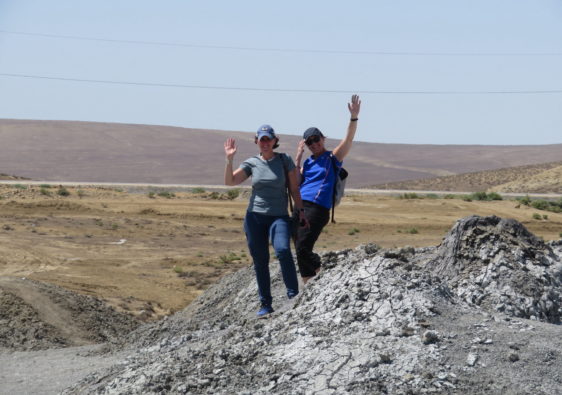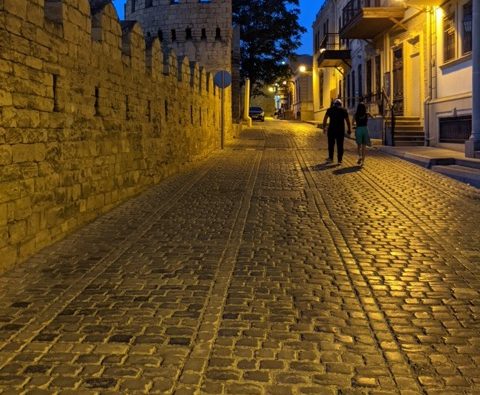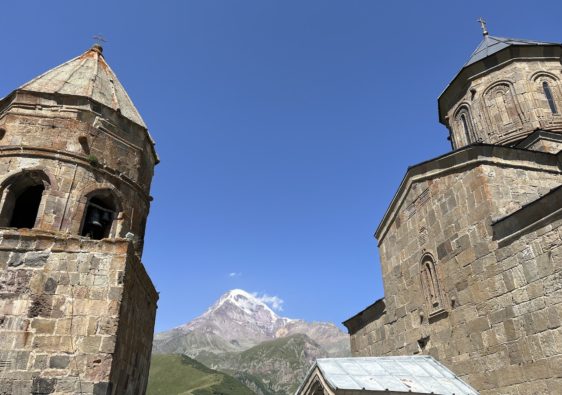#1. Mountains. Almost every picture you will see of the Caucasus region will feature gorgeous mountains. Georgia in particular has been featured on various social media “listicles” and almost always there is a photo of Kazbegi with the iconic Gergeti Trinity church in front of it. Armenia, Azerbaijan and Georgia are crossed by mountains, both the Greater Caucasus range which crosses Georgia and the top of Azerbaijan, and the Lesser Caucasus which is primarily in Armenia and creates a natural border with Azerbaijan. Mt Ararat, though technically in the easternmost portion of Turkey is visible from Armenia on a clear day and is a symbol of Armenia, with everything from beers to banks being called “Ararat.” Ararat is the supposed landing place for Noah’s arc. For us, while we do like to hike, we wanted to see as much as possible so chose multiple tours to see different mountain regions – Kazbegi in Georgia and Sheki in Azerbaijan – and were only able to do a small hike to a waterfall. If you are going to hike, check weather conditions and prepare accordingly. For us it was August and blazing hot, so even the short hike [uphill, at altitude, and in the 92F heat] was a challenge.
#2. Wine. Georgia is known for its wine, and we’re known for liking wine, so it seemed a natural fit! Georgia claims that it was the first wine-producing region, and there have been excavations over 8000 years old with wine sediment. Georgia has been producing wine using traditional methods – in a clay pot called a Qvevri that can range in size from smaller [holding several gallons] up to enormous jugs that can weigh tons. Armenia also claims to be the oldest wine-producing region, though Armenia also produces Cognac. We were told by multiple Georgians that Georgian wine is best, and Armenian cognac* is the best. And the wine is good, with a distinctive organic taste, slightly earthy. They have “amber” wines which are traditional and popular in Georgia but lesser known. They almost taste like a red wine, but lighter. They also have whites, reds, both dry and sweet. Sapuravi is the most common grape, but the taste of the Sapuravi wine will vary greatly depending on where it is grown. I liked the amber wine, but prefer the dry reds – but I liked each of the dry reds I tried [and yes, I tried a few!] Azerbaijan is a tea country and does not have the same focus on wine, but takes great pride in its tea.
*footnote: Though typically the name cognac should only be given to brandy produced in the Cognac region of France, Armenia has been using the name to apply for their brandy, which may have escaped notice because of the use of the Armenian and Russian writing. An agreement with the EU in 2021 will force them to not use the Cognac term by 2032.
#3. History and politics. Georgia, Armenia, and Azerbaijan are all former USSR, all gained independence in 1991 with the fall of the Soviet Union. We have previously traveled through multiple countries that were former-USSR, visited KGB museums, and were fascinated by the struggle for independence. Especially given the current conflict between Ukraine and Russia, the shadow of Russia looms large and we wanted to understand their perspective on Russia now.
- In Georgia, there was a very strong anti-Russia current. In 2008, in a 5-day conflict Russia invaded Georgia and took the Abkhazia and South Ossetia regions after long-standing tensions in the region. The young people we spoke to [those born after independence] chose to speak English versus Russian, and make their feelings about Russia known. Individual Russian tourists are still treated as guests by most, with resentment by others, the feelings against Russia as a country were universal with everyone we spoke to. Many volunteers in Georgia went to fight in Ukraine because they believe Russia is not stopped, Georgia would be next.
- In Azerbaijan, when we asked how the relationship with Russia is, the answer we got is, “we have to be their friends” – but the Azerbaijanis felt very vulnerable by being a small nation with a lot of oil and natural resources – a nation to be coveted and they believe the only one watching their back and keeping them from being invaded by Russia is Turkey.
- Armenia is the country with the strongest ties to Russia, but they also have choices. They are bordered by Azerbaijan, who they are in continual conflicts with – the most recent conflict with Azerbaijan was in 2020 – where they lost a contested portion of their land. They are also bordered by Turkey who, as the Ottoman empire, committed genocide against Armenia, killing a million Armenians in 1915 – 1917. Turkey maintains that the deportation was legitimate and does not acknowledge the genocide [making Turkey out as a possible ally]. Crushed between Turkey and Azerbaijan, Armenia can only look to Georgia and Russia to the north for support. As Georgia itself is not a rich country, Armenia has turned back to Russia more than any other country in the region.
#4. Affordability.
If you are looking for an interesting place to visit, but need to keep costs down, the Caucasus region is ideal, if you can find reasonable flights into the area. Once your flights are settled, you can find hotels and hostels at the lower end, but even the Marriot brands where we tend to stay if we can cobble together enough points were reasonable. We stayed at the Moxy hotels [a Marriott brand] in Tbilisi, and the cost was between 60 and 75 a night, depending on the day we booked. Food and drinks were extremely reasonable, though there is of course a range of costs. We had dinner near our hotel and paid 65 GEL – for 2 glasses of wine and 2 entrees and it was approximately $20 USD.
#5. Friendly. Georgia in particular places a high value on hospitality, and we felt welcomed into the country – and our guides and hosts at hotels or restaurants were very open and willing to answer any of our questions. We were treated like a guest in their country [and we always tried to be the best possible guests].
#6. Safe. For two women traveling alone, we never felt unsafe or threatened [with the possible exception of the highways which can be dangerous, even with experienced drivers. We did see multiple accidents on our journeys – and we were very happy we chose to travel with experienced drivers and guides, versus going it alone.] See the “Customs and in-country tips” for more on staying safe while traveling.



